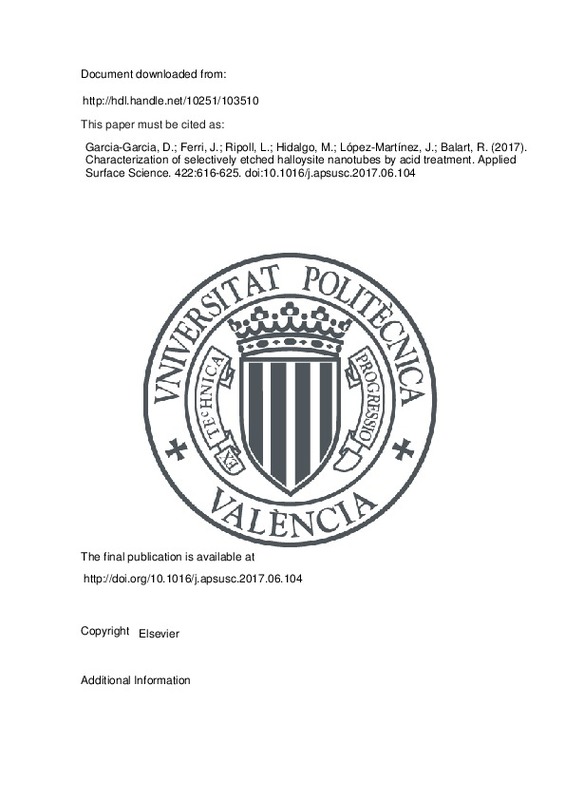JavaScript is disabled for your browser. Some features of this site may not work without it.
Buscar en RiuNet
Listar
Mi cuenta
Estadísticas
Ayuda RiuNet
Admin. UPV
Characterization of selectively etched halloysite nanotubes by acid treatment
Mostrar el registro sencillo del ítem
Ficheros en el ítem
| dc.contributor.author | Garcia-Garcia, D.
|
es_ES |
| dc.contributor.author | Ferri, J.M.
|
es_ES |
| dc.contributor.author | Ripoll, L.
|
es_ES |
| dc.contributor.author | Hidalgo, M.
|
es_ES |
| dc.contributor.author | López-Martínez, Juan
|
es_ES |
| dc.contributor.author | Balart, Rafael
|
es_ES |
| dc.date.accessioned | 2018-06-07T04:31:33Z | |
| dc.date.available | 2018-06-07T04:31:33Z | |
| dc.date.issued | 2017 | es_ES |
| dc.identifier.issn | 0169-4332 | es_ES |
| dc.identifier.uri | http://hdl.handle.net/10251/103510 | |
| dc.description.abstract | [EN] Halloysite nanotubes (HNTs) are a type of naturally occurring inorganic nanotubes that are characterized by a different composition between their external and internal walls. The internal walls are mainly composed of alumina whilst external walls are composed of silica. This particular structure offers a dual surface chemistry that allows different selective surface treatments which can be focused on increasing the lumen, increasing porosity, etc. In this work, HNTs were chemically treated with different acids (sulphuric, acetic and acrylic acid), for 72 h at a constant temperature of 50 °C. As per the obtained results, the treatment with sulphuric acid is highly aggressive and the particular shape of HNTs is almost lost, with a remarkable increase in porosity. The BET surface area increases from 52.9 (untreated HNTs) up to 132.4 m2 g−1 with sulphuric acid treatment, thus showing an interesting potential in the field of catalysis. On the other hand, the treatment with acetic acid led to milder effects with a noticeable increase in the lumen diameter that changed from 13.8 nm (untreated HNTs) up to 18.4 nm which the subsequent increase in the loading capacity by 77.8%. The aluminium content was measured by X-ray fluorescence (XRF) and laser induced breakdown spectroscopy (LIBS). The final results using two systems, suggest a good correlation between the acid strength and the aluminium reduction. Consequently, is possible to conclude that new applications for HNTs can be derived from selective etching with acids. Sulphuric acid widens the potential of HNTs in the field of catalysis while weak acids such as acetic and acrylic acids give a controlled and homogeneous lumen increase with the corresponding increase in the loading capacity. | es_ES |
| dc.description.sponsorship | This work was supported by the Ministry of Economy and Competitiveness - MINECO [MAT2014-59242-C2-1-R]. D. Garcia-Garcia wants to thanks the Spanish Ministry of Education, Culture and Sports for their financial support through an FPU grant [FPU13/06011]. | |
| dc.language | Inglés | es_ES |
| dc.publisher | Elsevier | es_ES |
| dc.relation.ispartof | Applied Surface Science | es_ES |
| dc.rights | Reconocimiento - No comercial - Sin obra derivada (by-nc-nd) | es_ES |
| dc.subject | Halloysite nanotubes | es_ES |
| dc.subject | Lumen enlargement | es_ES |
| dc.subject | Acid treatment | es_ES |
| dc.subject | Catalysis | es_ES |
| dc.subject | LIBS. | es_ES |
| dc.subject.classification | CIENCIA DE LOS MATERIALES E INGENIERIA METALURGICA | es_ES |
| dc.title | Characterization of selectively etched halloysite nanotubes by acid treatment | es_ES |
| dc.type | Artículo | es_ES |
| dc.identifier.doi | 10.1016/j.apsusc.2017.06.104 | es_ES |
| dc.relation.projectID | info:eu-repo/grantAgreement/MINECO//MAT2014-59242-C2-1-R/ES/TECNICAS AVANZADAS DE PROCESADO PARA SISTEMAS ACTIVOS ENCAPSULADOS/ | es_ES |
| dc.relation.projectID | info:eu-repo/grantAgreement/MECD//FPU13%2F06011/ES/FPU13%2F06011/ | es_ES |
| dc.rights.accessRights | Abierto | es_ES |
| dc.contributor.affiliation | Universitat Politècnica de València. Instituto de Tecnología de Materiales - Institut de Tecnologia de Materials | es_ES |
| dc.contributor.affiliation | Universitat Politècnica de València. Departamento de Ingeniería Mecánica y de Materiales - Departament d'Enginyeria Mecànica i de Materials | es_ES |
| dc.description.bibliographicCitation | Garcia-Garcia, D.; Ferri, J.; Ripoll, L.; Hidalgo, M.; López-Martínez, J.; Balart, R. (2017). Characterization of selectively etched halloysite nanotubes by acid treatment. Applied Surface Science. 422:616-625. https://doi.org/10.1016/j.apsusc.2017.06.104 | es_ES |
| dc.description.accrualMethod | S | es_ES |
| dc.relation.publisherversion | http://doi.org/10.1016/j.apsusc.2017.06.104 | es_ES |
| dc.description.upvformatpinicio | 616 | es_ES |
| dc.description.upvformatpfin | 625 | es_ES |
| dc.type.version | info:eu-repo/semantics/publishedVersion | es_ES |
| dc.description.volume | 422 | es_ES |
| dc.relation.pasarela | S\338753 | es_ES |
| dc.contributor.funder | Ministerio de Educación, Cultura y Deporte | es_ES |
| dc.contributor.funder | Ministerio de Economía y Competitividad | es_ES |







![[Cerrado]](/themes/UPV/images/candado.png)

